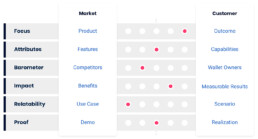When sales growth starts to decline, the first impulse most B2B vendors have is to build more to sell more. When that happens, your company can develop Productitis, a disease that negatively impacts your commercial systems. In highly complex and dynamic markets, the condition could be fatal. Here’s how to recognize the symptoms and cure Productitis.

What Is Productitis?
Productitis is the condition that exists when you believe the features and functions of your products and services are more valuable than how your customers experience what you provide.
Companies afflicted with Productitis focus their messaging and communication on themselves, and invest very little—if any—time understanding and empathizing with their customers’ business challenges.
Productitis is a systemic problem that infects your entire organization. The major symptoms are waste, inefficient commercial systems, overburdened salespeople, confused customers, and annoyed investors. Left unaddressed, it can kill your business.
How to Diagnose Productitis
Organizations with the highest risk of developing Productitis operate under a classic Go-to-Market (GTM) strategy. Rather than focusing on growing wallet share from the top 20 percent of accounts, GTM strategies drive the creation of more and more products, selling benefits, rather than outcomes.
Leaders can spot Productitis by evaluating their commercial systems for common go-to-market afflictions:

As a result, salespeople pursue and juggle a high volume of less lucrative deals, using an onslaught of disconnected tools, processes and content. Only a fraction of the top-performing salespeople can combat Productitis on their own. And the effort it takes to be successful under these conditions is heroic.

How to Cure Productitis
At its core, complexity is the combination of the number of moving parts and stakeholders in your business, multiplied by how the parts connect. Once you can see how the puzzle pieces fit together, you can solve for complexity through orchestration. Orchestration aligns people, process, information, and technology to customer value outcomes and business goals. Learn more about our proven approach to executing go-to-customer growth strategies.
Thinking in systems, you can orchestrate by design, creating a responsive antidote to pervasive Productitis.
Ultimately, you can move from the linear mindset of a go-to-market strategy and make the necessary shift to a go-to-customer strategy focused on delivering outcomes and co-creating demand with your customers.

With a coherent, repeatable system, you can focus on growth and ensure the commercial health of your business.
To learn more about Productitis and how it affects your commercial health, download The Go-to-Customer Transformation: Putting the Focus on Outcomes & Growth
Dave Irwin
Founder + CEO of Polaris I/O
Dave has 30 years of experience in B2B as President, GM, CMO, and CSO. He is recognized as an AI, marketing, and sales enablement expert. He is also a growth leader with a strong history of innovation.
Related Posts
The Business Case for the Commercial Insight Strategist: Unlocking Growth with Precision
In enterprise sales, growth is often…
The Commercial Insight Strategist: A Key Asset for Key Account Teams
Imagine a key account team working…



